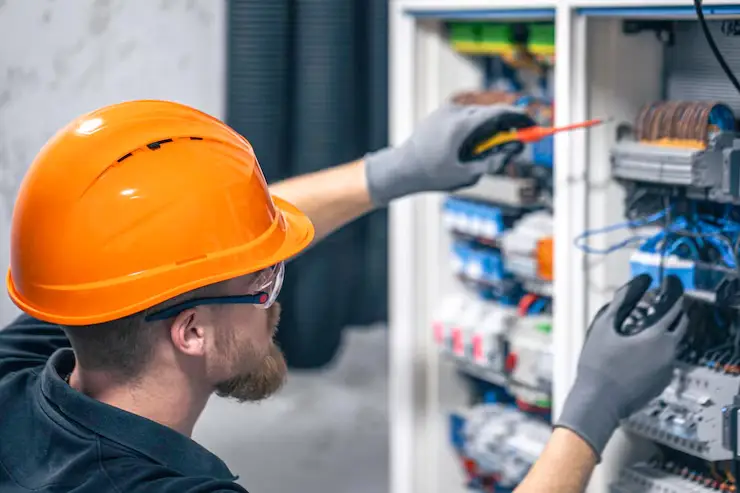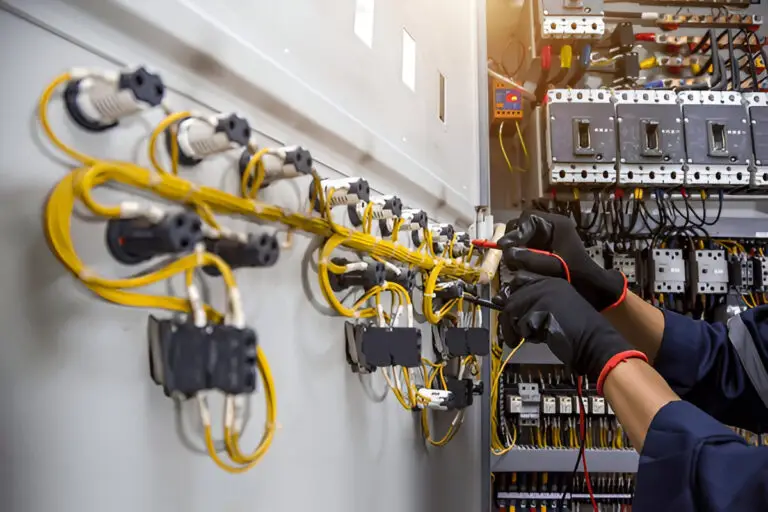Why Commercial Electrical Maintenance is a Non-Negotiable Investment?
The true cost of ignoring commercial electrical maintenance in Milwaukee is measured not in the small dollars saved on a quarterly inspection, but in the catastrophic ripple effect of failure: lost production, damaged reputation, and unacceptable safety liabilities.
n the competitive landscape of Milwaukee, where manufacturing facilities, healthcare systems, and corporate offices operate on razor-thin margins, continuous power is the absolute baseline for profitability. For too long, commercial electrical maintenance has been viewed as a discretionary expense—a budget item easily cut in the short term. However, this perspective is a costly gamble. Deferring routine care is not a cost-saving measure; it is a direct investment in future emergency premiums, massive unscheduled downtime, and severe regulatory penalties.
The true cost of ignoring commercial electrical maintenance includes unplanned commercial electrical downtime cost, steep OSHA fines for non-compliance, and premium emergency repair rates. Proactive commercial electrical maintenance and service, including Infrared Scanning and Arc Flash Studies, is essential in Milwaukee to ensure system reliability and compliance with NFPA 70E.
The True Cost of Commercial Electrical Downtime
When an electrical system fails due to component degradation or loose connections—issues easily identified during maintenance—the financial impact is immediate and devastating. For high-volume operations, a single hour of unplanned downtime costs exponentially more than an entire annual preventative maintenance contract.
1. The Immediate Financial Hit: The Multiplier Effect of Emergency
When a component fails due to deferred commercial electrical maintenance, the immediate costs are heavily inflated:
- Emergency Repair Premiums: Repairing critical switchgear or panels at 2:00 AM requires 24/7 Emergency Response rates. These service calls, which are the hallmark of reactive maintenance, are typically 3 to 5 times higher than the cost of a scheduled, non-critical repair.
- Asset Damage: An electrical fault, such as a power surge from a failing transfer switch or a short circuit in an overloaded panel, can cascade throughout the building. This can cause irreversible damage to expensive, long-lead-time equipment like industrial machinery, dedicated servers, or HVAC components, necessitating complete replacement.
- Wasted Labor and Overtime: Employees and production staff are immediately rendered idle, resulting in direct wage loss with zero productivity. Furthermore, management is forced to schedule costly overtime to try and catch up on missed production schedules.
2. The Hidden Cost of Lost Production and Reputation
Beyond the direct repair bill, the commercial electrical downtime cost creates long-term operational damage that is often difficult to quantify until it’s too late:
- Lost Revenue and Sales: For retail, hospitality, or service centers, every minute of downtime is a lost sales opportunity, potentially pushing frustrated customers permanently toward a competitor.
- Contractual Penalties: Businesses with Service Level Agreements (SLAs) or manufacturing contracts often face steep contractual penalties and fines for missed shipment deadlines or delayed production resulting directly from unscheduled outages.
- Inventory and Product Loss: In industries like food service, cold storage, or pharmaceuticals, a sustained power outage can lead to the complete spoilage and loss of thousands of dollars in perishable inventory, compounding the financial loss.
- Reputation Damage: Frequent, visible service interruptions erode customer confidence and can significantly damage a company’s reputation as a reliable supplier or service provider.
Regulatory and Liability Risks: Avoiding OSHA Fines
Ignoring commercial electrical maintenance is not just an operational risk; it is a major legal and safety liability, particularly for businesses operating under strict federal and state safety standards.
Can inadequate commercial electrical maintenance lead to OSHA fines?
Yes. While the Occupational Safety and Health Administration (OSHA) enforces its own standards, it relies heavily on consensus standards like NFPA 70E (Standard for Electrical Safety in the Workplace) and NFPA 70B (Standard for Electrical Equipment Maintenance) to support citations. Failure to perform maintenance or labeling can be used to justify serious violations.
1. The Mandatory Shift to NFPA 70B Compliance
The 2023 elevation of NFPA 70B from a guideline to a mandatory standard is a game-changer. It codifies the need for a documented Electrical Maintenance Program (EMP).
- The New Mandate: NFPA 70B requires equipment owners to establish and follow a documented maintenance schedule based on equipment condition, criticality, and failure history.
- Audit Risk: Insurance carriers and inspectors now have a clear standard to use when auditing maintenance practices. An undocumented or absent EMP increases liability exponentially.
2. The Arc Flash Liability
The need for an Arc Flash Study is a critical component of safety and liability management under NFPA 70E.
Why is an Arc Flash Study the foundation of commercial safety compliance?
An Arc Flash Study provides the necessary data to protect workers. It analyzes your electrical system to calculate the incident energy released during an electrical fault. This study is required to define safe work boundaries and determine the appropriate Personal Protective Equipment (PPE) for anyone working on or near energized equipment.
- Determines PPE: Identifies the correct arc-rated clothing and gear needed for specific tasks.
- Labeling: Creates mandatory, compliant warning labels for all electrical equipment, a fundamental requirement for worker safety.
- Risk Mitigation: By identifying high-risk areas, the study allows for mitigation strategies that physically lower the potential incident energy, permanently reducing hazard exposure.
The Preventive Advantage: How Diagnostic Services Drive ROI
The most effective commercial electrical service is proactive, condition-based, and predictive. Roman Electric employs advanced diagnostic tools to convert unpredictable risk into measurable return on investment (ROI).
What is the ROI of commercial electrical preventative maintenance?
The industry standard for preventative maintenance programs often shows a high return on investment, with savings ranging from $400\%$ to $700\%$ (according to various studies). This high return is realized because a small, predictable investment avoids massive, unpredictable costs associated with downtime, emergency repairs, and shortened asset life.
1. Infrared Scanning (Thermal Imaging)
How does Infrared Scanning prevent commercial electrical failures?
Infrared Scanning (or thermal imaging) is a non-invasive diagnostic technique that detects abnormal heat patterns caused by excessive resistance, loose connections, or overloaded components. Identifying these “hot spots” is the best method for finding defects before they become catastrophic failures.
- Identifies Faults: Locates loose connections, failing breakers, and unbalanced loads.
- Non-Invasive: Performed while equipment is energized (live), eliminating the need for scheduled shutdowns.
- Prevents Fire: Directly mitigates a leading cause of electrical fires in commercial buildings.
2. Comprehensive System Audits and Studies
Our maintenance division ensures long-term operational health through expert analysis:
- Feasibility Studies: A technical evaluation that determines if your current system can support future infrastructure (new machinery, EV Charging Stations, or full renovation), preventing costly overloads and installation errors.
- Coordination Studies: Ensures that protective devices (fuses and circuit breakers) are sequenced correctly. This ensures that when a fault occurs, only the nearest protective device trips, isolating the failure and minimizing the area affected by commercial electrical downtime.
- Troubleshooting & Repair: Beyond diagnostics, our expert team uses data gathered from scanning and studies to target and fix complex, recurring electrical faults permanently.
Tailoring Electrical Maintenance to the Milwaukee Market
Why does local expertise matter for commercial electrical maintenance in Wisconsin?
Local expertise is essential because Wisconsin experiences extreme seasonal weather, impacting electrical systems in unique ways. Roman Electric’s commercial electrical service Milwaukee teams are specifically trained to mitigate these regional challenges.
- Seasonal Load Swings: Maintenance plans are tailored to anticipate high-load periods, preventing failure caused by the combined stress of full HVAC systems in summer and complex heating circuits in winter.
- Corrosion Management: Exposure to road salt and extreme moisture requires special attention to exterior components, pole lighting, and underground conduits that are constantly compromised by the harsh winter environment.
- Local Code Adherence: We are current on all Milwaukee municipal amendments, ensuring guaranteed compliance that national firms often overlook, saving local businesses time and avoiding unexpected fines.
Cost Comparison: Preventive vs. Reactive Maintenance
This table clearly illustrates why a predictable investment in commercial electrical maintenance is superior to the high volatility of reactive costs.
| Cost Factor | Preventive Maintenance (PM) | Reactive Maintenance (RM) |
| Downtime Impact | Minimal, scheduled during off-hours or controlled shutdowns. | Catastrophic: Unscheduled, high-impact business interruption. |
| Emergency Rates | Zero (Work is planned). | High: Premium rates (3x regular cost) for after-hours labor and rush parts. |
| Equipment Lifespan | Extended by 50-75% due to proactive care. | Significantly shortened due to stress and catastrophic failure. |
| Safety/Compliance | High. Supported by documented Arc Flash Studies and EMP. | Low. High exposure to OSHA fines and major liability risk. |
Conclusion: The Strategic Investment in Commercial Electrical Service
The myth of saving money by skipping commercial electrical maintenance is easily debunked by the reality of commercial electrical downtime cost, massive OSHA fines, and the risk of catastrophic asset loss.
For any business in Milwaukee striving for maximum efficiency and uncompromised safety, commercial electrical maintenance and service is not an expense—it is a strategic investment in asset reliability and business continuity. By embracing proactive diagnostics like Infrared Scanning and the safety framework of NFPA 70B, you effectively convert unpredictable financial disasters into manageable, fixed operational costs.
Ready to protect your assets and eliminate the guesswork with Roman Electric from your facility management?.
Frequently Asked Questions
Q: What is the ROI of a Commercial Electrical Maintenance Plan?
The industry estimates a high return on investment (ROI) for preventative maintenance. This is achieved by avoiding the significantly higher costs of unscheduled commercial electrical downtime, emergency repairs, and equipment replacement.
Q: How often should I schedule Infrared Scanning for my equipment?
It is recommended that critical commercial electrical equipment receive an Infrared Scanning inspection at least once per year. High-demand or aging systems may require semi-annual checks to ensure safety and prevent failure.
Q: Can regular commercial electrical maintenance lower my insurance premiums?
Yes. Many insurance carriers view regular, documented commercial electrical maintenance (especially certified Infrared Scanning) as a proactive risk-reduction measure, which can lead to lower premiums and reduced liability exposure.
Q: How can I identify if I need an electrical panel upgrade?
Signs you need a panel upgrade include frequently tripping breakers, flickering lights, strange buzzing sounds from the panel, or outdated fuses. A Feasibility Study can definitively determine your need for increased capacity.
Q: What is NFPA 70B, and why did it become mandatory in 2023?
NFPA 70B is the standard for Electrical Equipment Maintenance. It became an enforceable standard in 2023 (previously a guideline) because neglecting maintenance was statistically proven to be a primary cause of major electrical failures, fires, and subsequent worker injuries.
Q: Do you provide 24/7 emergency electrical service for commercial problems?
Yes. Roman Electric provides guaranteed 24/7 Emergency Response for commercial electrical service across Southeastern Wisconsin, ensuring immediate expert help when your business experiences a critical electrical problem.
Q: What is an Arc Flash Study, and why is it needed for commercial electrical service?
An Arc Flash Study analyzes your electrical system to calculate the incident energy. It is required by NFPA 70E and OSHA to determine proper Personal Protective Equipment (PPE), set safe working boundaries, and ensure worker protection during electrical maintenance.







